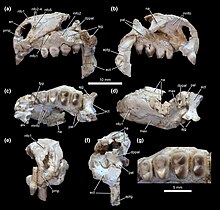| Hwiccewyrm Temporal range: Late Triassic, ~208–202 Ma PreꞒ Ꞓ O S D C P T J K Pg N | |
|---|---|

| |
| Holotype skull as seen from multiple angles | |
| Scientific classification | |
| Domain: | Eukaryota |
| Kingdom: | Animalia |
| Phylum: | Chordata |
| Class: | Reptilia |
| Clade: | †Parareptilia |
| Order: | †Procolophonomorpha |
| Family: | †Procolophonidae |
| Subfamily: | †Leptopleuroninae |
| Genus: | †Hwiccewyrm Butler et al., 2023 |
| Type species | |
| †Hwiccewyrm trispiculum Butler et al., 2023 | |
Hwiccewyrm (meaning "Hwicce dragon") is an extinct genus of leptopleuronine procolophonid parareptile from the Late Triassic Magnesian Conglomerate of England. The type, and currently only, species is H. trispiculum.
Discovery and naming

The holotype, specimen UMZC 2023.4.1, which is a partial skull, was discovered during the 1970s by Jeanne Evans and was likely found at Slickstones Quarry, Cromhall in an outcrop of the Magnesian Conglomerate. More specimens from the same species were later found at Slickstones Quarry, and were first described by Fraser (1988a) as belonging to an indeterminate procolophonid. The species is referred to as the 'Cromhall procolophonid' by Fraser (1988c) and as 'Procolophonid B' by Fraser (1994) and Edwards (2000).
The specimens were then referred to cf. Hypsognathus by Whiteside et al. (2016), and Butler et al. (2023) identified that the specimens belonged to a separate genus, naming it Hwiccewyrm trispiculum.
Classification
Ever since its discovery, Hwiccewyrm has been classified within Procolophonidae. In 2023, it was classified into the subfamily Leptopleuroninae.
Hwiccewyrm was found to be the sister-taxon to Hypsognathus, Soturnia and Leptopleuron.
References
- ^ Butler, R. J.; Meade, L. E.; Cleary, T. J.; McWhirter, K. T.; Brown, E. E.; Kemp, T. S.; Benito, J.; Fraser, N. C. (2023). "Hwiccewyrm trispiculum gen. et sp. nov., a new leptopleuronine procolophonid from the Late Triassic of southwest England". The Anatomical Record. doi:10.1002/ar.25316. PMID 37735997.
- ^ Fraser, N. C. (1988a). The osteology and relationships of Clevosaurus (Reptilia: Sphenodontida). Philosophical Transactions of the Royal Society of London, B321, 125–178.
- Fraser, N. C. (1988c). Latest Triassic terrestrial vertebrates and their biostratigraphy. Modern Geology, 13, 125–140.
- Fraser, N. C. (1994). Assemblages of small tetrapods from British Late Triassic fissure deposits. In N. C. Fraser & H.-D. Sues (Eds.), In the shadow of the dinosaurs (pp. 214–226). Cambridge University Press.
- Edwards, B. (2000). The Upper Triassic microvertebrate assemblage of Ruthin Quarry, South Wales. PhD, University College London, 390 pp.
- Whiteside, D. I., Duffin, C. J., Gill, P. G., Marshall, J. E. A., & Benton, M. J. (2016). The Late Triassic and Early Jurassic fissure faunas from Bristol and South Wales: Stratigraphy and setting. Palaeontologia Polonica, 67, 257–287.
| Procolophonia | ||||||||||||||||||||||||||||||||
|---|---|---|---|---|---|---|---|---|---|---|---|---|---|---|---|---|---|---|---|---|---|---|---|---|---|---|---|---|---|---|---|---|
| ||||||||||||||||||||||||||||||||
| ||||||||||||||||||||||||||||||||
This article about a Triassic reptile is a stub. You can help Misplaced Pages by expanding it. |

